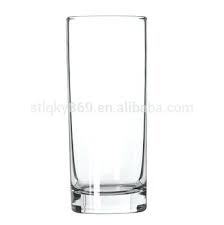Avoiding an accidental bottom's up
I have a narrow drinking glass that is an almost perfect cylinder. It's already pretty stable when empty but when full it can be knocked over rather easily. Question: how much water (to the nearest cubic centimeters) will make the glass most stable? (In other words, minimize the center of gravity.)
Some dimensions:
-
14.0 cm high
-
12.6 cm interior depth
- 7.1 cm exterior diameter
- 6.7 cm interior diameter
- mass 275 g
- water density is 1 gram per cubic centimeter

The answer is 85.
This section requires Javascript.
You are seeing this because something didn't load right. We suggest you, (a) try
refreshing the page, (b) enabling javascript if it is disabled on your browser and,
finally, (c)
loading the
non-javascript version of this page
. We're sorry about the hassle.
The first thing we need is the center of gravity of the empty glass. Let's make it relative to bottom of the inside of the glass.
The thick base volume is π ∗ 3 . 5 5 2 ∗ 1 . 4 = 5 5 . 4 3 c m 3 at a distance of − 0 . 7 c m
The cylindrical shell of the side is π ( 3 . 5 5 2 − 3 . 3 5 2 ) ∗ 1 2 . 6 = 5 4 . 6 3 c m 3 at a distance of 6 . 3 c m
Since the densities of these bits are the same we can find the center of gravity of the empty glass with a weighted mean
5 5 . 4 3 + 5 4 . 6 3 5 5 . 4 3 ∗ − 0 . 7 + 5 4 . 6 3 ∗ 6 . 3 = 2 . 7 7
Call the depth of the water x .
The water will add π ∗ 3 . 3 5 2 ∗ x = 3 5 . 2 6 x g r a m s at a height of 0 . 5 x c m . We can now find the cog as a function of x by another weighted mean:
C ( x ) = 2 7 5 + 3 5 . 2 6 x 2 . 7 7 ∗ 2 7 5 + 0 . 5 x ∗ 3 5 . 2 6 x
C ( x ) = 2 7 5 + 3 5 . 2 6 x 7 6 1 . 7 5 + 1 7 . 6 3 x 2
This will be minimized when the water level is the same as the cog (can you see why?)
2 7 5 + 3 5 . 2 6 x 7 6 1 . 7 5 + 1 7 . 6 3 x 2 ) = x
7 6 1 . 7 5 + 1 7 . 6 3 x 2 = 2 7 5 x + 3 5 . 2 6 x 2
0 = 1 7 . 6 3 x 2 + 2 7 5 x − 7 6 1 . 7 5
The quadratic equation has positive solution x = 2 . 4 0
Which corresponds to a mass of 3 5 . 2 6 ∗ 2 . 4 = 8 4 . 6 2 4 g or volume of 8 5 c m 3